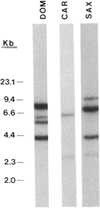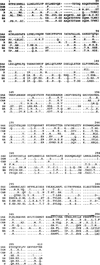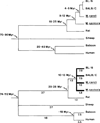Evolution of murine alpha 1-proteinase inhibitors: gene amplification and reactive center divergence
- PMID: 8169957
- PMCID: PMC4729375
- DOI: 10.1007/BF00166159
Evolution of murine alpha 1-proteinase inhibitors: gene amplification and reactive center divergence
Abstract
The organization and sequence of genes encoding the alpha 1-proteinase inhibitor (alpha 1PI), a major serine proteinase inhibitor of the mammalian bloodstream, have been compared in several species, including murine rodents (genus Mus). Analysis of gene copy number indicates that amplification of alpha 1PI genes occurred at some time during evolution of the Mus genus, leading to fixation of a family of about three to five genes in several existing species (e.g., M. domesticus and M. saxicola), and only a single gene in others (e.g., M. caroli). A phylogeny for the various mammalian alpha 1PI mRNAs was constructed based upon synonymous substitutions within coding regions. The mRNAs in different murine species diverged from a common ancestor before the formation of the first species lineages of the Mus genus, i.e., about 10-13 million years ago. Thus, alpha 1PI gene amplification must have occurred prior to Mus speciation; gene families were retained in some, but not all, murine species. The reactive center region of the alpha 1PI polypeptide, which determines target protease specificity, has diverged rapidly during evolution of the Mus species, but not during evolution of other mammalian species included in the analysis. It is likely that this accelerated evolution of the reactive center, which has been noted previously for serine proteinase inhibitors, was driven by some sort of a positive Darwinian selection that was exerted in a taxon-specific manner. We suggest that evolution of alpha 1PI genes of murine rodents has been characterized by both modification of gene copy number and rapid reactive center divergence. These processes may have resulted in a broadened repertoire of proteinase inhibitors that was evolutionarily advantageous during Mus speciation.
Figures





Similar articles
-
Patterns of divergence during evolution of alpha 1-proteinase inhibitors in mammals.Mol Biol Evol. 1996 Feb;13(2):346-58. doi: 10.1093/oxfordjournals.molbev.a025594. Mol Biol Evol. 1996. PMID: 8587500
-
Expression of the alpha 1-proteinase inhibitor gene family during evolution of the genus Mus.Mol Biol Evol. 1997 Apr;14(4):420-7. doi: 10.1093/oxfordjournals.molbev.a025778. Mol Biol Evol. 1997. PMID: 9100372
-
Highly conserved upstream regions of the alpha 1-antitrypsin gene in two mouse species govern liver-specific expression by different mechanisms.Mol Cell Biol. 1990 Feb;10(2):760-9. doi: 10.1128/mcb.10.2.760-769.1990. Mol Cell Biol. 1990. PMID: 1689000 Free PMC article.
-
Structure and expression of human IFN-alpha genes.Philos Trans R Soc Lond B Biol Sci. 1982 Sep 24;299(1094):7-28. doi: 10.1098/rstb.1982.0102. Philos Trans R Soc Lond B Biol Sci. 1982. PMID: 6128751 Review.
-
A review and comparison of the murine alpha1-antitrypsin and alpha1-antichymotrypsin multigene clusters with the human clade A serpins.Genomics. 2003 Mar;81(3):336-45. doi: 10.1016/s0888-7543(02)00041-1. Genomics. 2003. PMID: 12659817 Review.
Cited by
-
Asymmetric mutation rates at enzyme-inhibitor interfaces: implications for the protein-protein docking problem.Protein Sci. 2003 Sep;12(9):2099-103. doi: 10.1110/ps.0306303. Protein Sci. 2003. PMID: 12931008 Free PMC article.
-
Tandem duplication of serpin genes yields functional variation and snake venom inhibitors.bioRxiv [Preprint]. 2025 Jan 10:2025.01.07.631777. doi: 10.1101/2025.01.07.631777. bioRxiv. 2025. PMID: 39829938 Free PMC article. Preprint.
-
Synonymous and nonsynonymous substitutions in mammalian genes and the nearly neutral theory.J Mol Evol. 1995 Jan;40(1):56-63. doi: 10.1007/BF00166595. J Mol Evol. 1995. PMID: 7714912
References
-
- Banyal HS, Misra GC, Gupta CM, Dutta GP. Involvement of malarial proteases in the interaction between the parasite and host erythrocyte in Plasmodium knowlesi infections. J Parasitol. 1981;67:623–626. - PubMed
-
- Benton WD, Davis RW. Screening λgt recombinant clones by hybridization to single plaques in situ. Science. 1973;196:180–182. - PubMed
-
- Berger FG, Baumann H. An evolutionary switch in tissue-specific gene expression: abundant expression of α1-antitrypsin in the kidney of a wild mouse species. J Biol Chem. 1985;260:1160–1165. - PubMed
Publication types
MeSH terms
Substances
Associated data
- Actions
- Actions
- Actions
- Actions
Grants and funding
LinkOut - more resources
Full Text Sources
Molecular Biology Databases
